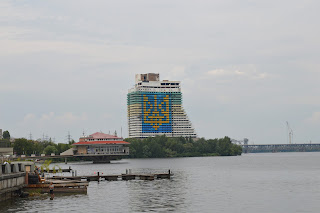I travelled down from Dnipropetrovsk to Zaporizhia by bus, the route roughly following the course of the Dnieper River. It was wartime in Eastern Ukraine. A couple of hundred kilometres east of here, battle was raging in the city of Donetsk. I had spent two months in Dnipropetrovsk eight years earlier, in the winter of 2006. This was a Russian-speaking region, but everything I had learned about Dnipro during that earlier stay told me that most of its people would stand with Ukraine. And it proved to be so. Blue and yellow Ukrainian flags flew from buildings. They adorned cars. An electronic billboard in the city centre displayed a fluttering flag, while the national anthem blared across the square. Most striking of all, a whole tower block on the Dnieper riverbank had been faced with a vast yellow on blue trident symbol of Ukraine.
The regional governor, Igor Kolomoisky, one of Ukraine’s wealthy oligarchs, had taken on the defence of the city, recruiting his own militia, the Dnipro Battalion. My bus passed through one of its checkpoints as we drove into the city. It had also seen action further east. Kolomoisky is Jewish, surely giving the lie to Russian slurs that the authorities in Ukraine are fascist. Dnipro boasts the biggest Jewish community in the country. Kolomoisky had built the huge Menorah Jewish community centre in the city (I stayed in a hotel in the building).
During my earlier stay in Dnipropetrovsk, people had more than once spoken of their pride in the Cossack heritage of the region. The centre of that heritage was in Zaporizhia, a little way south down the Dnieper, and I had long wanted to go there. Zaporizhia itself is a non-descript Soviet-era city. It has no real centre of any note, just an avenue, many kilometres long, with other avenues leading off it. Its most noteworthy construction is the vast Dnieper dam, built in the late 1920s and early 1930s, and once the pride, the showcase of Stalin’s first five year plan. Before the construction of the dam, and the flooding it caused, this section of the river was known for its rapids, from which Zaporizhia, ‘beyond the rapids’, takes its name.
Looking across from the dam, in the middle of the broad Dnieper, is the long island of Khortytsia, famous as a centre of the Zaporizhian Cossacks. From the 16th through to the 18th centuries, the Cossacks held sway over a large territory known as the Zaporizhian Sich, or sometimes as the Cossack Republic. The word ‘sich’ was derived from the Ukrainian word for ‘to chop’, referring to the clearance of forest to make room for an encampment, and the use of the wood to build a fortification. It was this fortified camp that formed the heart of the Zaporizhian Cossack world. The term was used to refer to the fortification itself, and also to the wider territory it controlled. The Sich enjoyed varying degrees of autonomy, at times coming under the formal sovereignty of both the Polish-Lithuanian Commonwealth and of Muscovy. Some believe its origin was as a defence against the raids of Crimean Tartar slavers, the so-called ‘harvesting of the Steppe’, which carried off hundreds of thousands of Ukrainians and others into bondage. The Sich was destroyed several times, by the Tartars among others, only to be rebuilt at a different spot. It was finally abolished by Catherine the Great in 1775. For today’s Ukrainians, the Zaporizhian Sich was one of the antecedents of the modern Ukrainian state.
Like Cossacks elsewhere, the Zaporizhian host was made up of men who had sought freedom from the strictures of organised states and from the serfdom prevalent in Poland and Russia. The value they placed on freedom was reflected in their model of government, which included elements of democracy. Authority was exercised by an assembly, the ‘Sich Rada’, and the ‘Hetman’, or leader. The island of Khortytsia, the centre of the Zaporizhian Cossacks’ realm, was strictly male only. The Cossacks had a code of behaviour and a judicial system to enforce it.
There is nothing left of the original Sich on Khortytsia, all trace having been erased on the order of Catherine. But there is a museum, including exhibits from the period of the Sich, as well as pictures depicting the Cossacks’ rebellion against Poland-Lithuania, the Khemelnytsky uprising, in 1648. The Cossacks look splendid and terrifying in their extravagant costumes and outsized moustaches. Other pictures of assemblies in the Sich show them raucous and wild, as they would be expected to be. Close-by the museum is a reconstruction of the Sich, including walls made of wooden stakes, as well as houses and, at the centre, a tall, wooden Orthodox Church. But it is difficult to conjure up the atmosphere of former times, especially with the dam nearby, as well as massive electricity pylons a short distance away.
There is something ineffably glamorous about the Cossacks. But their image is also tainted by a reputation for violence. In later periods, in the service of the Russian Tsars, they were often seen as the sharp edge of Tsarist oppression against subject peoples. They have tended to be regarded as a part of the Russian heritage, and indeed, until recently, much of the world barely distinguished Ukraine from Russia. In the present conflict, there have been reports of Cossacks fighting on the side of the Russian invaders, and abducting international monitors. But many Ukrainians also draw inspiration from their Cossack past. In the sprawling camps in central Kyiv in the aftermath of the Maidan revolution, several of the men hanging around in military fatigues, practicing martial arts and swilling hard liquor, had adopted the styles of the Cossacks, with the profuse moustaches and shaven heads, with just a small wisp of hair swept forward from the top of their sculls, over their foreheads. But these were not the ones fighting in the east to recover Ukraine’s occupied territory.



No comments:
Post a Comment